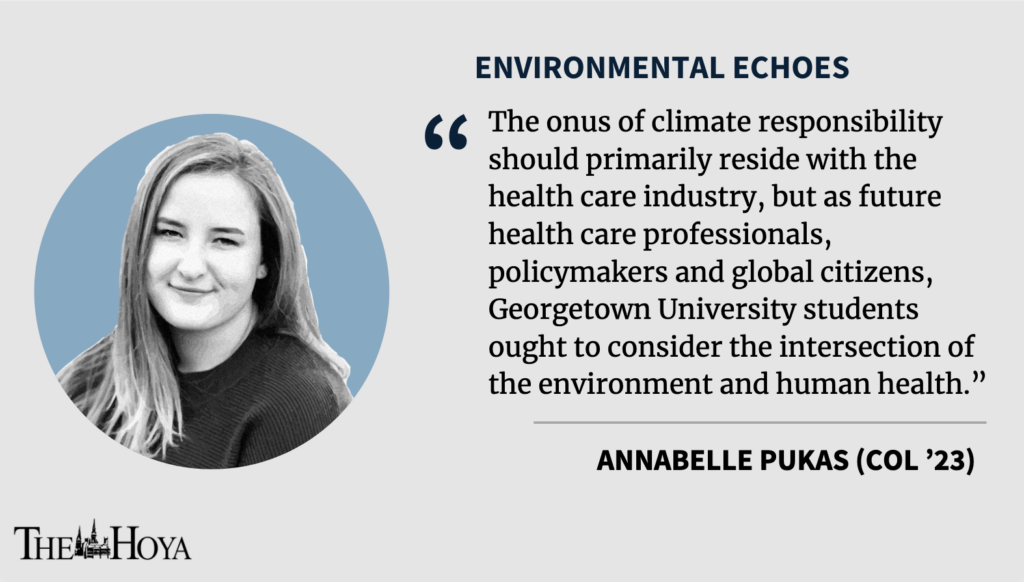The health care industry is designed to keep people healthy, but in order to prevent irreparable damage to the health of the planet and everyone on it, the industry must assume responsibility and take action to reduce its environmental footprint.
If the global health care sector were a country — based on its current emissions — it would be the world’s fifth-largest emitter of greenhouse gases. The United States and China are the largest contributors to this number, accounting for 27% and 17% of global emissions, respectively.
In the United States, health care is responsible for nearly one-tenth of all greenhouse gas emissions, and in-patient health care alone is the second-largest commercial energy consumer. The average hospital generates more than a pound of hazardous waste per bed each day, and pharmaceutical waste that has the potential to disrupt our natural bodily functions is present in 80% of U.S. water streams. Even the manufacturing, distribution and use of just a single inhaler has the same environmental impact as driving 180 miles, or about the distance from Washington, D.C., to Norfolk, Virginia.
The health care industry’s failure to address its environmental impact has created a paradoxical reality in which health care itself causes extreme climate-related health crises around the globe. Higher temperatures and more prevalent pollutants negatively affect the body by increasing instances of heart, lung and neurological diseases while also degrading mental health. Greater incidence of these conditions places a heavier burden on the health care industry and ultimately leads to a greater loss of life.
This loss of life is tremendous: estimates suggest that 5 million people already die each year because of a decline in environmental health, and 23% of total global deaths are attributable to preventable environmental factors. Without broad action, approximately 250,000 additional deaths will be added to these tolls yearly from 2030 to 2050. If there is one industry that should be wholly invested in preventing these deaths, it is the health care industry.
Luckily, analyses of the health care sector’s failures demonstrate exactly where it can improve. More than half of health care’s carbon footprint stems from energy use, meaning there is great potential to transition to renewable energy sources and reduce overall consumption where possible. For example, the Cleveland Clinic, a top-ranking medical center, reduced the air replacement rate in unoccupied operating rooms from 20 times an hour to six, saving $2 million per year on its energy bill while seeing no change in health outcomes of its patients after operation.
Further, the severity of health care systems’ total pollution correlates with the number of clinical procedures performed. Preventative care and investment in community wellness programs could create healthier populations, reduce the number of subsequent medical procedures needed and ultimately halt deleterious pollution at the source. Federal, state and local governments should invest in their communities’ health by procuring access to fresh, nutritious and plant-based food, encouraging consistent exercise, educating patients on proper medication disposal, ensuring housing and discouraging substance abuse.
Finally, the health care sector should embrace telemedicine even after the end of the COVID-19 pandemic. From 2005 to 2010, the University of California, Davis performed 13,000 outpatient telehealth consultations, which eliminated the need for 4.7 million miles of patient travel and prevented the consumption of 188,000 gallons of gas, equivalent to 1,700 metric tons of reduced carbon emissions. The UC Davis clinic is modest in size but effectively demonstrates how transformative telehealth can be.
Georgetown University students are uniquely positioned to learn about the bridge between climate health and public health and to ultimately carry this knowledge into their future professions. Georgetown offers several classes that directly evaluate the relationship between the environment and human health, such as “Saving the Planet, Saving Lives,” “Global Environmental Health” and “Health Impacts of the Environment.”
The university’s location and alumni base also allow students access to both policymakers and many different international health-focused organizations such as the Global Health Council, the World Bank, and the World Health Organization. The onus of climate responsibility should primarily reside with the health care industry, but as future health care professionals, policymakers and global citizens, Georgetown students ought to consider the intersection of the environment and human health.
The future path of climate-related health consequences is treacherous; the health care sector must invest in sustainable growth and realize an ounce of prevention is truly worth a pound of cure.
Annabelle Pukas is a sophomore in the College. Environmental Echoes appears online every other Friday.










Dr. Laura Anderko • Mar 5, 2021 at 9:06 pm
Great article, an important topic! Health Care Without Harm (www.noharm.org) is an organization that has successfully assisted health care systems reduce their energy footprint.